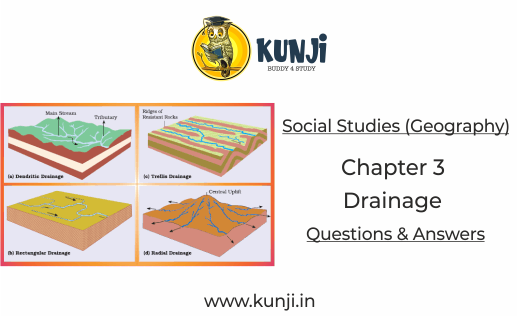NCERT Solutions for class 9th Geography chapter 3
In this chapter you will find solutions to the chapter drainage system in India. The drainage system in India describes the rivers and their system in India. The chapter gives insight to the Himalayan rivers and Peninsular rivers, the lakes and also the role of rivers in the economy of a country. you will get all answers to NCERT Geography Chapter 3 drainage. NCERT is prescribed for CBSE.
NCERT solutions for class 9 Social Studies (Geography) chapter 3 – Drainage
Here are the Solutions for chapter 3 geography. You can also check NCERT solutions for class 9 for all subjects.
Q1. Choose the right answer from the four alternatives given below
1. In which of the following states is Wular Lake located?
a ) Rajasthan
b) Punjab
c) Uttar Pradesh
d) Jammu and Kashmir
Ans: d) Jammu and Kashmir
2. the river Narmada has its source at?
a) Satpura
b) Amarkantak
c) Brahmagiri
d) Slopes of the Western Ghat
Ans: b) Amarkantak
3. Which of the following is a salt water lake?
a) Sambhar
b) Wular
c) Dal
d) Gobind Sagar
Ans: a) Sambhar
4. The following is the longest river in Peninsular India?
a) Narmada
b) Godavari
c) Krishna
d) Mahanadi
Ans: b) Godavari
5. Which one among the following rivers flows through a rift Valley?
a) Mahanadi
b) Krishna
c) Tungabhadra
d) Tapi
Ans: d) Tapi
Q2. The following questions briefly.
1. What is meant by a water divide? give an example.
Ans: Any elevated area, such as a mountain or an upland, which separates two drainage basins is called a water divide.
2. Which Is the largest river basin in India
Ans: Ganga river basin is the largest river basin in India
3. Where do the rivers Indus and Ganga have their origin?
Ans: Indus originates near Mansarovar lake in Tibet. The river Ganga originates in Gangotri glacier in Uttaranchal.
4. Name the two headstreams of Ganga. Where do they meet to form the river Ganga?
Ans: Two headstreams of Ganga Alaknanda and Bhagirathi. Both of these meet to form the river Ganga at Devprayag.
5. Why does the Brahmaputra in its Tibetan part have less silt despite a longer course?
Ans: In Tibet, the river Brahmaputra carries a small volume of water and less silt since it is a cold and dry area. In India it passes through the region of heavy rainfall and therefore the river carries a large volume of water and also a considerable amount of silt.
6. Which two peninsular rivers flow through trough?
Ans: Narmada and Tapi are the two peninsular rivers flow through trough.
7. Some economic benefits of rivers and lakes
Ans: Since ancient time rivers have been of great importance. Water from the rivers is a natural resource and essential for the existence of human beings. It is required for all activities. This is the reason that since ancient times people have settled on the banks of rivers. Rivers are used for irrigation, navigation and even power generation. In India rivers have a great significance because of it’s requirement in agriculture. Agriculture is the main occupation in India.
Q3. Below are the names of few Lakes in India. Group them under two categories- natural and Created by humans.
Ans: Natural Lakes
Wular
Dal
Nainital
Bhimtal
Loktal
Chilika
Pulicat
Sambhar
Barapani
Man Made
Gobind Sagar
Rana Pratap Sagar
Nizam Sagar
Nagarjuan Sagar
Hirakund
Q4. Discuss the significant difference between the Himalayan and the peninsular rivers
Ans: Himalayan rivers
1. these are perennial rivers
2. they receive water from rains and snowfall
peninsular rivers
1. These are seasonal rivers
2. These are dependent on rainfall. During the dry season they get dried up.
Q5. Compare the East flowing and the west flowing rivers of the peninsular plateau.
West flowing rivers
There are only two long West flowing rivers that is Narmada and Tapi
They flow into the Arabian Sea
They have lesson number of tributaries
Form estuaries
They carry lesser sediments
East Flowing rivers
Major rivers Mahanadi, Kaveri, Godavari and Krishna
They flow into the Bay of Bengal
Have many tributaries
Form deltas
Carry larger sediments than West flowing rivers
Q6. Why are rivers important for the country’s economy?
Ans: Since ancient time rivers have been of great importance. Water from the rivers is a natural resource and essential for the existence of human beings. It is required for all activities. This is the reason that since ancient times people have settled on the banks of rivers. Rivers are used for irrigation, navigation and even power generation. In India rivers have a great significance because of its requirement in agriculture. Agriculture is the main occupation in India.
Also See:
- Forest Society and Colonialism History Class 9 Chapter 4 Question Answers
- Geography Chapter 1 India Size and Location Class 9 Question Answers
- Physical Features of India Geography Class 9 Chapter 2 Question Answers
- Socialism in Europe and Russian Revolution History Class 9 Chapter 2
- Nazism and the Rise of Hitler Class 9 History Chapter 3 Solutions
- The French Revolution History Class 9 Chapter 1 Solutions
- Matter In Our Surroundings Class 9 Science Chapter 1





